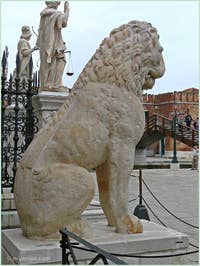Squares Arsenal | Hunchback | Dogana | Colleoni | Rioba | Piazzetta St. Mark | Stefano | Rialto Vecchio
The squares and sculptures of Venice

The Lion of Piraeus Whether associated with religious buildings or palaces or more simply dotted around the facades of houses, sometimes a single small round medallion under a window, above a door.
And the sculptors of Venice have left us some magnificent works, as original as they are beautiful.
Meetings to make
It's often as you walk along that the sculptures of Venice come across each other.And these are often genuine encounters between your gaze and the sculpture you've just discovered.
Human... Sculptures
How can I explain this to you... these sculptures, like the whole city, are human, are so close to us that we let ourselves be taken in by them.
Antonio Rioba Mastelli They question us, challenge us, are often mysterious, heavy with symbols often forgotten by our computerised, sanitised societies.
Legends and Mysteries
The sculptures in Venice evoke legends and mysteries, lions, birds, lambs... most often devouring each other. Who's who?A Military Past
But they are also there to remind us of Venice's glorious past, a past that was often military, uncompromising, but an uncompromisingness that was often also in the service of the defence of freedom, of that freedom yet still so rare at the time.Religious Statuary
But statuary also knows how to be angelic, in the service of the love of God, of the saints, omnipresent in Venice, which built its reputation on the relics of St. Mark the evangelist.Polychrome sculptures
You will discover magnificent polychrome sculptures most often preserved in churches.We invite you to discover with us in the pages of e-Venice.com a glimpse of the wonders hidden in Venice.
Corte, Campi, Campielli, Piazza... in Venice
Originally, the Campi (Campo in the singular) were rammed earth and cultivated, hence their name which means fields in our language.Almost always located in front of a church and now paved, today they are popular living and meeting places for Venetians, young and old alike.
In fact, all these campi and campielli are ideal playgrounds for little Venetians, who play football or go cycling on them, even though this is forbidden in Venice.
Another unavoidable feature of a campo is the cafés - parents have to be taken care of too, and this is what gives the campi their lively, friendly atmosphere.
If you haven't already heard, Venetians love to talk!
In autumn or winter, this is also the place where the sun is able to warm us for the longest time, as it doesn't need to plunge into the heart of narrow Calli to do so.
What also makes the campi particularly attractive in Venice is the sense of space they exude.
After meandering through narrow, winding Calli, arriving at a large campo, such as Santa Margherita or Santo Stefano, is always a pleasure: the space!
You can take a deep breath, the view can finally carry you far and Venice suddenly seems bigger!
Squares Arsenal | Hunchback | Dogana | Colleoni | Rioba | Piazzetta St. Mark | Stefano | Rialto Vecchio
Back to Top of Page

